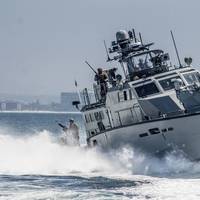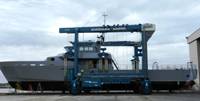The Navy’s Big Fleet of Small Boats

The Navy is known for its big ships. It has a lot of smaller boats and craft, too—3,200 of them.The three primary stakeholders for these craft are the Surface Fleet, Commander Navy Installations Command and Navy Expeditionary Combat Command. Other stakeholders include Submarine Forces; Air Forces (which own the aircraft carriers); Naval Special Warfare; the Coast Guard; Naval Facilities Command and the Naval Warfare Centers.Boats and craft are procured and managed by Naval Sea Systems Command (NAVSEA) Program Executive Office for Ships (PEO Ships)…
Ike Launch of Nulka Successful
The aircraft carrier USS Dwight D. Eisenhower (CVN 69) (Ike) completed the first successful carrier launch of the MK 234 Nulka countermeasure fired from the MK 53 Decoy Launching System (DLS), Dec. 16. Nulka, an Australian Aboriginal word meaning to "be quick," is a rapid-response active expendable decoy (AED) capable of providing highly effective defense for ships against modern anti-ship missiles (ASM). The decoy was developed through a joint effort by Australia and the United States. Australia developed the hovering rocket while the U.S. developed the electronic payload. When launched, the Nulka decoy radiates a large, ship-like radar cross section that attempts to lure ASMs away from their intended targets.
RiverHawk's Multimission Platform Launched

RiverHawk Launches First-of-Class Advanced Multimission Platform (AMP) at Tampa Yard. RiverHawk Fast Sea Frames (RHFSF) has launched its signature Advanced Multimission Platform (AMP) at its shipyard in Tampa, Florida. Fully designed and built in the United States, the 145-foot coastal security craft was contracted 12 months ago by the U S Department of the Navy’s Naval Sea Systems Command (NAVSEA) to Maritime Security Strategies (MSS) of Tampa, Florida. RiverHawk designed, produced and is outfitting the ship, scheduled for final delivery to NAVSEA in May.
Surface Ship Life Cycle Mngmt Stands Up
The Naval Sea Systems Command (NAVSEA) formally established the Surface Ship Life Cycle Management (SSLCM) Activity on May 8, 2009, in a ceremony at Norfolk Naval Shipyard (NNSY) in Portsmouth, Va. The new activity, a NAVSEA program office, will be aligned under the Deputy Commander for Surface Warfare (SEA 21). The SSLCM Activity will maintain, monitor and refine Class Maintenance Plans for all non-nuclear surface ships to ensure material readiness for the projected service life, develop life-cycle strategies to address system upgrades, and fully implement the Integrated Class Maintenance Plan into each surface ship's maintenance schedule and availability planning process.
LPD 17 Construction on Course
The steel profile of San Antonio, the first ship of the LPD 17 class, can now be seen rising along the banks of the Mississippi River at Northrop Grumman Ship Systems in Avondale, La. technologies that will enhance the amphibious fleet's operational flexibility. Osprey. The San Antonio construction program enjoyed some recent successes, thanks to a new incentive program established by NAVSEA's LPD-17 program office. The program provides incentives to the shipyard to enhance efficiencies and complete construction phases on schedule and within budget. San Antonio construction achieved its 10 percent completion milestone in February 2002 and is quickly nearing its 20 percent production objective. schedule. There is significant progress in other areas as well.
NASSCO Starts Construction on Second T-AKE Ship

completed the first cut and signed off on the first steel piece for the second T-AKE ship, to be named the Sacagawea. The Navy has awarded NASSCO contracts for six of a potential 12-ship fleet of new dry cargo/ammunition ships. General Dynamics, has begun construction on the second ship in the T-AKE program, a new class of combat logistics force ships designated the Lewis and Clark class. Mrs. DeAnne Sutton, wife of U.S. Navy Commander George Sutton of the NAVSEA Program Office, made the first cut on the ship's first steel plate to signify the start of construction. The U.S.
NASSCO Starts Second T-AKE Ship
National Steel and Shipbuilding Company (NASSCO) has begun construction on the second ship in the T-AKE program, a new class of combat logistics force ships designated the Lewis and Clark class. Mrs. DeAnne Sutton, wife of U.S. Navy Commander George Sutton of the NAVSEA Program Office, made the first cut on the ship's first steel plate to signify the start of construction. The U.S. Navy has awarded NASSCO contracts for six new dry cargo/ammunition ships for a total contract value of $1.87 billion. The T-AKE contract includes options for an additional six ships, eventually creating a 12-ship fleet of new combat logistics force ships. If all the options are exercised, the 12-ship program would have a total value of $3.7 billion and become the largest contract in NASSCO's history.
Northrop Grumman Completes Builder's Trials on Ronald Reagan
Northrop Grumman Corporation announced that the nation's newest and most advanced nuclear-powered aircraft carrier, Ronald Reagan (CVN 76), returned to the Newport News sector following successful completion of initial sea trials. The sea trials are an aggressive series of operational tests to demonstrate that Reagan's two nuclear propulsion plants and their operators are fully mission capable. Adm. Frank L. "Skip" Bowman, director of the U.S. Naval Nuclear Propulsion Program, conducted the initial sea trials. Bowman concluded that Reagan's propulsion plants and their operators met or exceeded expectations. Also taking part in the sea trials were Tom Schievelbein, Northrop Grumman corporate vice president and president of the Newport News sector; Rear Adm.
Northrop Grumman Completes Builder's Trials on Ronald Reagan
Northrop Grumman Corporation announced that the nation's newest and most advanced nuclear-powered aircraft carrier, Ronald Reagan (CVN 76), returned to the Newport News sector following successful completion of initial sea trials. The sea trials are an aggressive series of operational tests to demonstrate that Reagan's two nuclear propulsion plants and their operators are fully mission capable. Adm. Frank L. "Skip" Bowman, director of the U.S. Naval Nuclear Propulsion Program, conducted the initial sea trials. Bowman concluded that Reagan's propulsion plants and their operators met or exceeded expectations. Also taking part in the sea trials were Tom Schievelbein, Northrop Grumman corporate vice president and president of the Newport News sector; Rear Adm.
MK 41 VLS Receives NAVSEA Award
In a ceremony yesterday attended by Rep. Dutch Ruppersberger (D-MD), Baltimore County officials and senior U.S. Navy leadership, Lockheed Martin received the Naval Sea Systems Command (NAVSEA) Excellence Award for consistently exceeding design, production, and quality challenges as the prime contractor for the MK 41 Vertical Launching System (VLS), installed aboard the U.S. Navy’s Aegis-equipped cruisers and destroyers. Capt. Mick Outten, U.S. Navy Program Manager for the MK 41 VLS, said, “I believe that the MK 41 VLS program is one of the great success stories of today’s modern Navy.” He continued, “The MK 41 VLS program is a model…
USS San Antonio Steps Mast
As part of crew move aboard, the crew of the future USS San Antonio (LPD 17) officially “stepped” their Advanced Enclosed Mast/Sensor System (AEM/S) recently. Normally, a ship’s Mast Stepping occurs earlier in conjunction with ship christening, but delaying this event until now enabled all of future San Antonio’s crew to be present. The ancient custom of “stepping the mast,” by placing coins under the step or bottom of a ship’s mast during construction, dates from antiquity. One belief from Greek Mythology is that should the ship be wrecked during passage, the coins would ensure payment of the crew’s wages for their return home. Since at least the construction of USS Constitution, this tradition has been passed on as a symbol of good luck for U.S. Navy ships.





